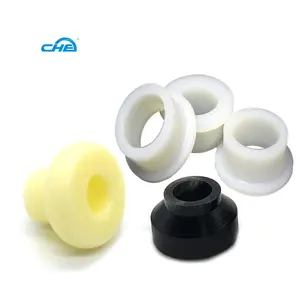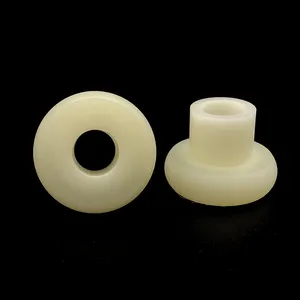
All categories
Featured selections
Trade Assurance
Buyer Central
Help Center
Get the app
Become a supplier

(1206 products available)

































There are several types of damper bushings, and each has distinct traits and applications. Choosing the ideal type for a certain application depends on the working circumstances, stresses endured, and the needed level of dampening and flexibility. The following are some common variations:
These are the most commonly used bushings, and they are made from natural or synthetic rubber. This material provides a good balance of vibration dampening and flexibility. As such, it is widely used in automotive applications, machinery, and equipment where vibration control and noise reduction are needed.
Featuring a fluid-filled core, these bushings absorb and damp vibrations via the fluid's resistance to motion. This provides better energy absorption than the elastic element alone. The bushings work well in heavy industrial and automotive applications that experience considerable dynamic loads and vibrations.
This is a synthetic elastomer used to make bushings. Thanks to its tensile strength, this material is resistant to wear and tough environments. Thus, they provide moderate vibration dampening. Because of their rigidity, they are ideal in applications where one needs durability and minimal deflection. Some situations are in heavy machinery and conveyor systems.
These combine the strength of metals with rubber's dampening capability. Often, one half of the bushing is made of metal, while the other half consists of rubber or elastomer embedded in the metal. This construction improves the bushing's durability and allows efficient vibration dampening, making it suitable for heavy machinery and structural applications.
These are designed to provide flexibility in multiple directions. They are highly effective against small amplitude oscillations, especially in vehicles, where they isolate critical components from vibrations. Further, one can customize them to specific frequencies, which is useful in fine-tuning suspension systems.
A damper bushing is a critical component used in many industrial applications. In these settings, damper bushings are vital for controlling vibrations, minimizing noise, and extending the lifespan of machinery. Here is a rundown of the environments where this component is mostly found:
In this space, damper bushings are used in suspension systems to absorb shocks and vibrations. This improves ride comfort and vehicle handling. Further, they isolate engine vibrations from the chassis and other components. This reduces noise transmission to the vehicle's interior, enhancing passenger comfort. It's worth noting that there is more reliance on advanced bushing materials, such as hydraulic and metal-rubber composites, due to the rising complexity of modern vehicles.
Heavily vibrating machinery and equipment rely on damper bushings. For instance, in industrial machinery, vibrating motors, generators, and pumps have these bushings. Here, they reduce harmful vibrations that can cause wear, damage, or misalignment over time. They also protect sensitive components from the effects of vibration in precision equipment.
Similarly, aerospace components are no exception, as they use damper bushings to minimize vibration and ensure structural integrity. They are found in aircraft engines, landing gear, and control surfaces. In these applications, they increase passenger safety and comfort and protect critical avionics from the adverse effects of continuous vibrations during flight.
Rubber bushings are used in boat engines, propellers, and other marine machinery to absorb vibrations and shocks caused by waves and engine operation. In addition to enhancing comfort on boats, bushings protect the integrity of components, ensuring they withstand the harsh marine environment and last longer.
As is the case in all the other spaces, heavy machinery and construction equipment such as excavators, bulldozers, and loaders incorporate damper bushings in their suspension systems. They cushion the operator's cabin from vibrations, enhancing comfort during use. These bushings also extend the life of critical components by reducing the impact of oscillations on the internal electronic parts of the machines.
For effective long-term performance, one must understand damper bushing specifications and maintenance requirements. Damper bushing specifications assess their appropriateness for a certain application. At the same time, proper maintenance ensures optimal performance in the long run. Here is a breakdown:
Material composition
The damper bushing's material greatly influences its properties. For instance, rubber bushings provide flexibility and good vibration dampening, while polyurethane offers resilience and durability. Conversely, metal-rubber composites enhance strength and vibrational isolation.
Damping coefficient
This coefficient indicates the bushing's capacity to dissipate vibrational energy. It is often measured in units of force per velocity, where a higher value means better damping. It is particularly important in dynamic applications, as it directly impacts how well the bushing can control oscillations.
Load capacity
How much load a damper bushing can carry depends on the application at hand. In dynamic situations, one should always consider peak load to avoid future component failures. In most cases, hydraulic and metal-rubber bushings have a higher load capacity than their rubber or polyurethane counterparts.
Temperature resistance
This is especially true where the operating environment experiences extreme heat or cold. Here, one should consider the bushings' material's thermal stability. For instance, automotive or aerospace applications use materials that endure great temperatures.
Hardness
The Shore hardness scale often measures a bushing's hardness. A softer bushing provides greater isolation from vibrations. On the other hand, a stiffer one tends to bear mechanical loads better while offering less damping. Therefore, choose the appropriate hardness level for the application at hand.
Design and size
The size and design of damper bushings vary widely based on the specific application. As such, analyze whether the current bushing's dimensions will fit appropriately within the intended system. Moreover, carefully examine the design to ensure it meets the mechanical requirements.
Visual inspections
These should be done quite often. Other than this, the maintenance team does a visual inspection of the bushings for signs of wear such as cracks, deformity, or any fluid leakage where hydraulic bushings are used. Catching these signs early minimizes system failure and downtime.
Regular cleaning
This is needed to remove dirt, debris, or corrosive material that may have accumulated over time. Such particles could damage the bushing material.
Lubrication
Some damper bushes require proper lubrication now and then to minimize friction between the bushing and its mounted surfaces. This is especially true for metal-rubber and polyurethane bushings. Use compatible lubes based on the bushing type so as not to degrade the material.
Regular monitoring
This helps to check for signs of functional degradation, such as increased noise, vibration levels, or decreased isolation capability. Monitoring these factors aids early problem detection and supports timely component replacement.
Hydraulic bushings checks
Hydraulic damper bushings require special maintenance considerations such as checking for fluid leakage and ensuring the internal fluid levels are appropriate. If any leakage occurs, it should be fixed immediately to prevent a reduction in damping effectiveness, which can negatively impact system stability.
Environmental protection
Some bushings are more sensitive to environmental conditions than others. For instance, bushings in outdoor or extreme-condition installations are more likely to be affected by UV radiation, moisture, or extreme temperatures. Therefore, apply protective measures like covers or seals to extend their lifespan.
Choose a suitable damper bushing by following the understanding of the application's needs and the bushing's specifications. Below are the key considerations:
Application requirements
Clearly define the purpose of the bushing in the given context. This includes estimating the vibrations' magnitude and frequency and the load conditions to which the bushing will be subjected. In dynamic applications, use a hydraulic or metal-rubber composite bushing as it has high vibrational energy. Conversely, one will find a rubber or polyurethane bushing more suitable for low-energy vibrations.
Material selection
As seen, damper bushings are made from several materials, each one with its own advantages. Rubber bushings are ideal for general vibration isolation, while hydraulic bushings are suitable for heavy-duty applications requiring great energy absorption. Polyurethane provides enhanced durability in industrial settings. In automotive and aerospace, go for metal-rubber composites, which endure dynamic loads while offering robust isolation.
Load capacity and strength
Choose a bushing that can withstand the system's maximum load without failing. In this case, consider both static and dynamic loads, and do not forget to include any peaks that might occur. Refer to the manufacturer's load rating to ensure the bushing meets these criteria. Also, pay attention to the bushing's construction. For instance, hydraulic and metal-rubber bushings usually have better load-carrying capabilities than rubber or polyurethane ones.
Operating conditions
What are the environmental conditions in which the bushing will operate? Is it extreme temperature, moisture, or exposure to chemicals? All these play a huge role in selecting the appropriate damper bushing. Hydraulic bushings are particularly good in harsh environments due to their internal sealing. On the other hand, outdoor applications need bushings made of rubber that have UV and ozone protective properties.
Durability and maintenance
How much is the required maintenance for the bushing? Some bushings, like hydraulic ones, need periodic checks for leaks and fluid replacement. Others, such as rubber or polyurethane, need less frequent substitution. If the application demands high reliability and low downtime, then go for a bushing type that has excellent durability along with low maintenance. Metal-rubber composite or hydraulic bushings are suitable for heavy-duty and mission-critical applications.
A1. Rubbers are by far the most widely used. They provide a decent balance between flexibility and durability. Because of this, they are favored by industries like automotive, machinery, and aerospace. Their versatility allows them to be applied in a broader range of everyday consumer goods and industrial machinery.
A2. In heavy machinery, these bushings minimize vibrations from high-power engines and large moving parts. The bushings protect the operator's cabin and sensitive components from excessive bouncing and shaking. As for the machinery itself, the bushing decreases wear and tear on internal parts, enhancing the machines' longevity and reliability.
A3. They do require some maintenance, but not a lot. The key is ensuring they do not leak fluid, as that lowers their efficiency in absorbing shocks. Regular monitoring for signs of fluid leaks and occasional bushing replacement will help keep these bushings in good working condition for many years, especially in dynamic and heavy-load applications.
A4. Picking the right bushing for the application and environmental conditions improves durability. Next, go for high-quality materials, be they rubber, metal, or hydraulic. Further, frequent visual inspections, cleaning, lubrication, and proactive replacement help prolong bushing life. Finally, preventive maintenance goes a long way in catching early signs of wear and tear, preventing total failure, and keeping the bushing functional for many more years.